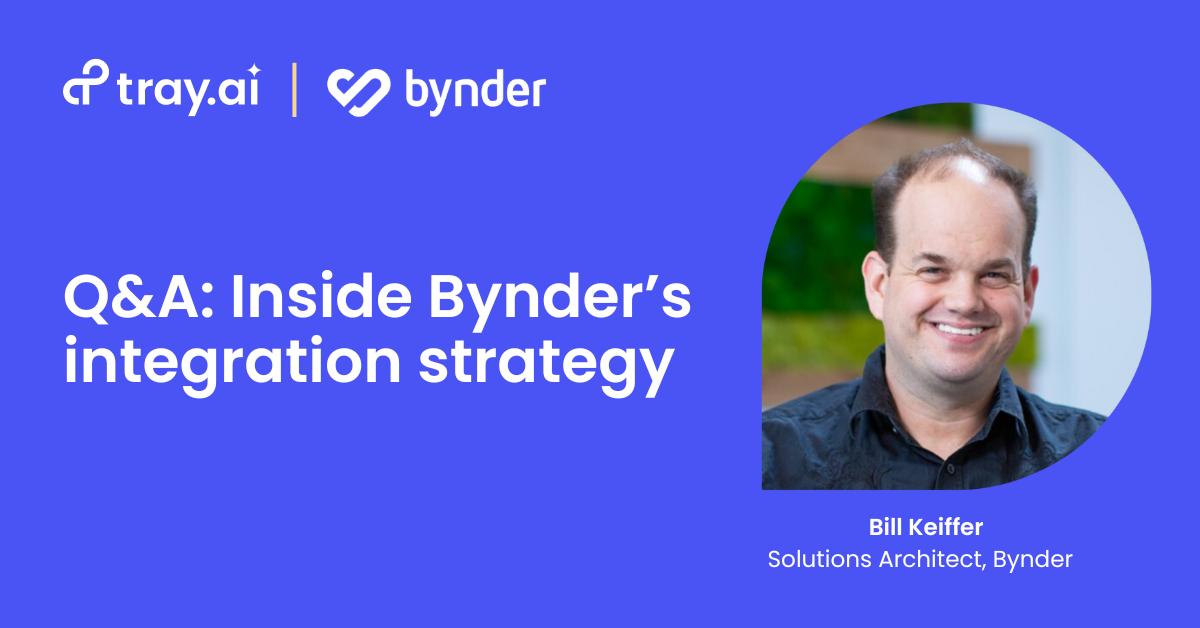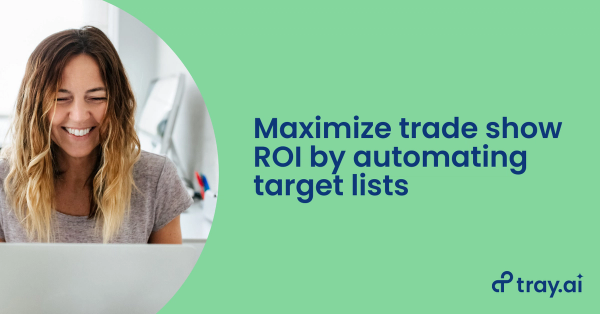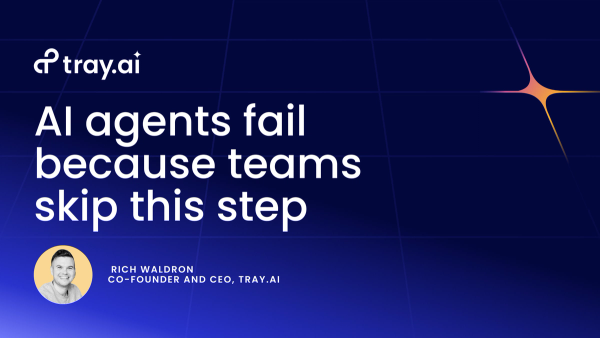We recently had the pleasure of chatting with Bill Keiffer, Solutions Architect at Bynder, a leading digital asset management (DAM) platform. For Bynder’s customers, the ability to easily integrate various tools and services is crucial for managing diverse content efficiently. In our conversation, Bill shared his insights on how Bynder leverages the power of the Tray Universal Automation Cloud to accelerate the delivery of high-quality integrations to enhance efficiency and deliver exceptional value to their clients.
Let’s dive into the conversation and explore how Bynder is making waves in the world of digital asset management with Tray.ai.
1. Hi Bill, thanks so much for taking the time to talk with us today about Bynder and the Tray-powered integrations you offer customers. Can you give us an overview of Bynder and how it uses the Tray platform?
Sure thing. Bynder is a digital asset management platform used by some of the most iconic brands around the world to manage their content lifecycle. Content comes in many different forms from many different places so, as you can imagine, offering a wide range of integrations within our product is a core value driver for us and is really important for our customers.
I’m a Solutions Architect at Bynder which means I oversee the various integrations we offer. These integrations are powered by the Tray Universal Automation Cloud, which we’ve embedded directly into our product and appears as a self-service integration marketplace for our customers.
2. What were some of the integration challenges you faced before deciding to use Tray to embed integrations directly into the Bynder application?
Initially, we built integrations in-house or with partners which was a huge lift and required significant time, maintenance, and technical expertise. Building integrations in-house comes with some very big problems. As you add more and more, the amount of maintenance that goes into keeping them running grows. We knew it wasn’t sustainable, especially as we entered this rapid growth phase.
Partners can be a great resource to build integrations. But we would end up in situations where we want to offer an integration that’s very important to us, but that integration is not nearly as important to our partners. They may be poorly maintained, and then we have a bad customer experience.
So embedding an iPaaS was the obvious solution for us since we could embed a fully functioning integration platform into our application, and offer powerful integrations at a reasonable cost.
3. So what led you to choose Tray as your integration platform?
A few departments at Bynder were already using Tray to integrate and automate some internal processes. Additionally, we had chosen Tray to be a preferred vendor of ours. So what that means is when a client came to us and said, “Hey, we want to build this integration. Can you recommend a platform?” Of all the iPaaS platforms out there, we decided to recommend Tray.
So through that relationship, we were already aware of Tray's technical prowess, ease of use, and scalability. When we started running into these integration challenges, we evaluated many different solutions, including expanding our partner play or building a specialized team.
However, our existing relationship with Tray and the positive feedback from our engineering and product teams made it a clear choice. We knew we had a partner that we could work with. We knew that it was a powerful platform that could do what we wanted. So it was a natural progression for our relationship with Tray, and it’s been a complete success.
4. How has Tray impacted your integration development speed and efficiency?
Since adopting Tray, we’ve significantly improved our integration output. To put it in perspective, before Tray, we managed to roll out six or seven integrations in the span of about three or four years. In the 18 months that we’ve had Tray, we’ve rolled out around 30.
This velocity boost has been orders of magnitude better than what we could achieve through traditional engineering pipelines.
5. What kind of cost savings have you seen by using Tray?
Before Tray, building a single integration involved an entire team of people working for weeks or even months. You can imagine with just the direct costs of those salaries, you know, that's expensive. But in addition to that, you also have QA issues. We have DevOps that has to create the infrastructure that the integration can run on. And then all the maintenance goes into that, server maintenance, the DevOps resources to continuously keep track of it. All of those things together are significant direct costs, but also a significant overhead.
With Tray, we remove a lot of those costs. We remove the huge teams. We remove all the DevOps overhead. We remove that QA team. And we essentially can just build with a handful of people. Now, it's just me and one other person managing around 30 integrations for hundreds of clients, which has been a great bargain.
6. What impact has Tray had on Bynder's customer experience?
Tray absolutely has improved our customer experience by making integrations more affordable and responsive. We're now able to offer integrations at a lower cost, so clients can connect systems that were previously too expensive for us to consider building. And that's been a springboard for us to build and integrate even much more complex and much more engaging integrations for them.
The other big point of the customer experience that has greatly improved is our ability to respond to issues in the integrations. When building integrations, inevitably, you are going to run into bugs, you're going to run into problems, you're going to run into situations that you didn't foresee and you didn't test for. With Tray, we can see those issues in real time, so we can go in and look at the logs, fix it on the fly, and deploy within hours or sometimes even minutes. That improved responsiveness has been a huge driver of our client experience and a big part of why many of our clients get a lot of value out of the integrations we offer.
7. You talked about custom-built or partner-built integrations being unreliable. Has building integrations on Tray improved reliability?
Absolutely. In the two years we've been using Tray, it has been nothing but reliable. When anyone in my organization or a client asks, “Can you do this with some integration or with some process?” I can always say yes, knowing that Tray can handle anything we throw at it. It has run solidly, reliably, and at scale 24 hours a day, 365 days a year.
8. Did you feel that there was a steep learning curve for building integrations on Tray?
With any platform, there is going to be a learning curve. Tray is unique in its combination of ease of use and power. So to me, I think it's very accessible for both novices and experienced engineers to ramp up quickly and also see immense value out of the things they are able to build in a short amount of time.
I also feel like the platform is continuously innovating, with features like the Connector Developer Kit and the new enhanced AI capabilities, so there are always new things to learn. I love that Tray offers tons of resources for learning about Tray. For instance, I’m a big fan of the Tray Community as it’s been an invaluable resource for me in my builder journey.
9. How important is community engagement for using Tray effectively?
Being an active member of the Tray Community has been a huge part of my building ability. Learning from and sharing knowledge with other users enriches our understanding and application of the platform. Real-time interactions with fellow builders is the best as it lets me solve problems quickly and gain a lot of unique insights from other builders.
10. As you know, Tray.io is now Tray.ai to better reflect our focus on integration and automation with AI—through our augmented building capabilities—and for AI—by infusing AI into business processes. How is AI influencing Bynder's future with Tray?
AI is a big part of our strategy at Bynder, driven by the needs of our clients who manage vast amounts of assets. We're excited about the potential of Tray for future integrations and functionality enhancements. Clients are constantly coming up with ideas for AI-driven features, and we're looking forward to exploring these possibilities with Tray.ai.
Get the full Bynder story
From significant cost savings to enhanced customer experiences, Bynder’s integration strategy has proven to be a key driver of their continued success. To learn more about Bynder’s journey and how Tray.ai accelerated their integration capabilities, be sure to check out our in-depth case study.




